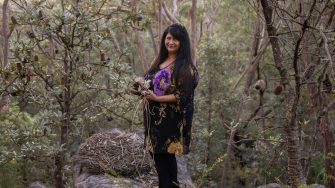Barangga artist Debra Beale’s healing journey
UNSW Art & Design Fine Arts student Debra Beale’s work in fashion and cultural adornment features natural dyes and objects she finds as she walks in the bush.
UNSW Art & Design Fine Arts student Debra Beale’s work in fashion and cultural adornment features natural dyes and objects she finds as she walks in the bush.

UNSW Galleries current exhibition, barangga, is a celebration of First Nations design practices and cultural knowledge. The exhibition, which was born out of gatherings of First Nations designers in 2022, is a way of sharing and passing on the skills and the stories of the designers, as well as exhibiting their work. And designer and maker Debra Beale was invited by a friend to take part.
Beale has been creating since she was a child, making things from what she finds, what she notices and what the ancestors put in her path. Back then, in Griffith, she’d go to the tip and marvel at what people threw out. Some things were brand new. Nowadays she cruises through op shops and Reverse Garbage in Marrickville, Sydney. She was upcycling before upcycling was a word.
“I get a lot of my inspiration from turning old things people throw away into something new,” she says.
That and the bush. “For me it’s like I’m on a healing journey, so when I’m walking, I’ll come across a feather, or something, and it’s like the ancestors left it there for me, and I’ll pick it up and take it home. Add it to my collection. And when I start working, I’ll come across that object, and it fits with what I’m doing.” Beale lives in Warrimoo, formally known as Karabah (Where Eagles Land) in the Blue Mountains, Darug Nation. “It is my home and a place where I can connect to my deepest inner self,” she says.
“I am passionate about accessing and sharing my Aboriginal art and culture, using contemporary media to connect with traditional themes, through mediums such as Australian bush jewellery, paintings, sculptures, sculpture installations, photography, ceramics and textiles.”
A heritage that led to displacement
Beale’s mob comes from the Palawa/Yorta Yorta and Gamilaraay/Wonnarua nations, and it meant her youth was affected by an Australian culture that forced her family into a resettlement program, and that told her she wasn’t smart enough to study past Year 10. (Her classmate Stan Grant was told the same thing. His father took him to Canberra to finish his schooling. Beale went to Bathurst.) While she didn’t complete school, Beale took part in traineeships, opened an Aboriginal preschool (still running today), raised three sons and continued to create — especially cultural adornments with three really good friends back in the 90s.
“We would make adornments taking something from the bush, the rainforest, the ocean and the desert.” Which led to other projects like making paper embedded with natural materials. “One project leads to another,” explains Beale. “They are all connected.”
Beale first studied art as part of a pilot course in Aboriginal Art and Fashion at CIT in Canberra 30 years ago. She was inspired by the renowned First Nations artist Bronwyn Bancroft, who was one of the first Australians to put her clothes on the global runway. The course involved putting design on to fabric through processes like screen printing.
A heritage that led to healing
And that inspiration has powerfully shaped Beale’s artistic direction. Finding ways to incorporate her culture into her design. During the yarning that grew into the barangga exhibition she says, “It was really inspiring to reconnect with people I hadn’t seen in twenty years, and to see how far they’ve come.”
It was part of the reason she got in touch with the Global Indigenous Runway folk and asked if there was any chance she could put her clothes on the runway this year.
Another process, she would describe as part of the healing. “I wanted to tell my story. I was holding something inside and I needed to get that out, but I wasn’t quite sure how I was going to exhibit it.” Her Sacred 1 Collection ended up both opening and closing the Global Indigenous Runway event.
The story Beale wanted to share is a hard one. “It’s about having a voice and people are not listening. I wanted to start my journey of healing. And that means I have to acknowledge what’s happening and move on. In the clothing, there’s layers of trauma, intergenerational trauma, transgenerational trauma. I hear stories about our young people, deaths in custody, children being taken away, it was just so devastating for me to see that this is still going on. I just created work… there was a lot of blood, sweat and tears in creating that. I kept redyeing the cloth.”
When people look at the collection, they see beauty, and that’s “because it’s a healing journey,” explains Beale. “It’s like people smiling but underneath there’s a story. It’s embedded in the cloth. The healing process is the beauty of it.”
From a young woman who was relocated because of her Aboriginality and told she wasn’t smart enough to finish school, Beale has reconnected with her culture, and with her people, and now wants to speak into the lives of young Aboriginal people, help them build strengths, share cultural knowledge. “I love sharing, what I know, what I’ve learned and stories that I hold. If I can help one young Aboriginal person that’s an achievement for me and hopefully it’s like a ripple effect.’
Beale is about to commence a stint as a Solid Ground Artist in Residence with Carriageworks.
The barangga Exhibition will be at UNSW Galleries Paddington until July 30.